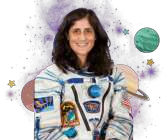EVS Notes for Chapter 11 Sunita in Space Class 5 - FREE PDF Download
FAQs on Sunita in Space Class 5 EVS Chapter 11 CBSE Notes - 2025-26
1. What are the key points to remember for a quick revision of the chapter 'Sunita in Space'?
For a quick revision, focus on these main ideas: life in a spaceship (how astronauts eat, sleep, and float), the concept of zero gravity and its effects, Sunita Williams's experiences and records, the appearance of Earth from space (a blue globe with no borders), and the difference between stars, satellites, and shooting stars.
2. Why do things float in a spaceship, as described in the chapter?
Things float in a spaceship because it is in space, where the pull of Earth's gravity is extremely weak. On Earth, gravity is a force that pulls everything downwards, which is why we stay on the ground. In space, this force is almost absent, causing astronauts and objects to float around in a state often called microgravity.
3. How does the chapter explain the appearance of the Earth from space?
Sunita Williams describes the Earth from space as looking like a beautiful blue and white globe. The blue part is water, and the white is clouds. A key summary point is that from that height, you cannot see any borders or lines dividing countries. This view shows that the Earth is one big, shared home for everyone.
4. What is the main difference between the Earth and the Moon mentioned in the chapter?
The primary difference highlighted is that the Earth is a planet, while the Moon is its natural satellite. A planet is a large celestial body that orbits a star (like our Sun), whereas a satellite is an object that orbits a planet. The chapter uses this to explain the basic relationships between objects in our solar system.
5. What was different about daily activities like eating and combing hair in space?
Daily activities were very different due to zero gravity. Key points to revise are:
- Eating: Food would float away if not caught. Astronauts had to grab floating food blobs to eat.
- Water: Water didn't stay in one place but floated as blobs. They used a wet cloth to wash their faces.
- Hair: Hair didn't hang down but stood up, floating all the time. Sunita Williams famously mentioned her hair kept standing.
6. How does this chapter help us understand the concept of a globe?
The chapter 'Sunita in Space' provides a real-life account that proves the Earth is round like a globe. When Sunita Williams looked at the Earth from her spaceship, she saw it as a large, round sphere, not a flat surface. This personal observation helps students visualise and confirm that the globes we use in classrooms are accurate models of our planet.
7. What key details should be included in a short summary of Sunita Williams's experience for Class 5?
A good summary should mention that Sunita Williams is an American astronaut of Indian-Slovenian origin who spent a long time in space. Key points to include are her experiences with zero gravity, like her hair standing up and food floating, her view of the beautiful Earth without borders, and her passion for science which she wanted to share with children.
8. How are shooting stars different from the stars we see every night?
A key concept to revise is that the stars we see every night are giant, burning balls of gas very far away, much like our Sun. A shooting star, however, is not a star. It is actually a small piece of rock or dust called a meteoroid that enters Earth's atmosphere, burns up due to friction, and creates a bright, fast-moving streak of light.





























